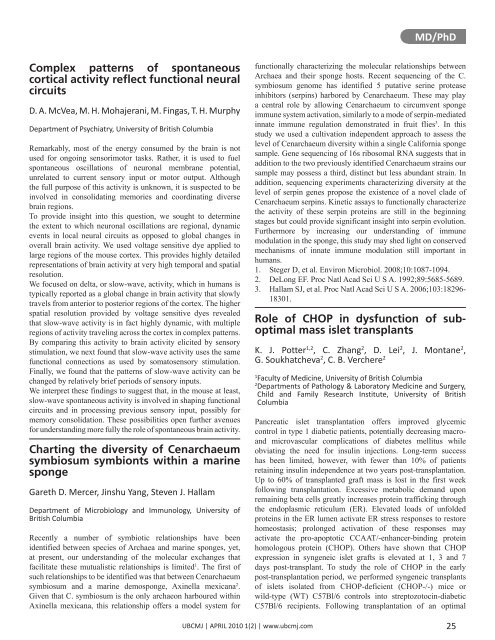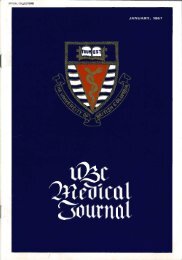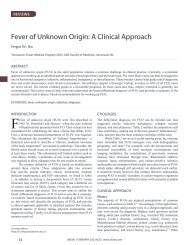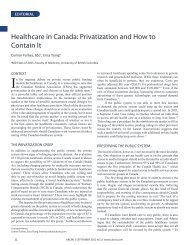Download full PDF - UBC Medical Journal
Download full PDF - UBC Medical Journal
Download full PDF - UBC Medical Journal
Create successful ePaper yourself
Turn your PDF publications into a flip-book with our unique Google optimized e-Paper software.
MD/PhD<br />
Complex patterns of spontaneous<br />
cortical activity reflect functional neural<br />
circuits<br />
D. A. McVea, M. H. Mohajerani, M. Fingas, T. H. Murphy<br />
Department of Psychiatry, University of British Columbia<br />
Remarkably, most of the energy consumed by the brain is not<br />
used for ongoing sensorimotor tasks. Rather, it is used to fuel<br />
spontaneous oscillations of neuronal membrane potential,<br />
unrelated to current sensory input or motor output. Although<br />
the <strong>full</strong> purpose of this activity is unknown, it is suspected to be<br />
involved in consolidating memories and coordinating diverse<br />
brain regions.<br />
To provide insight into this question, we sought to determine<br />
the extent to which neuronal oscillations are regional, dynamic<br />
events in local neural circuits as opposed to global changes in<br />
overall brain activity. We used voltage sensitive dye applied to<br />
large regions of the mouse cortex. This provides highly detailed<br />
representations of brain activity at very high temporal and spatial<br />
resolution.<br />
We focused on delta, or slow-wave, activity, which in humans is<br />
typically reported as a global change in brain activity that slowly<br />
travels from anterior to posterior regions of the cortex. The higher<br />
spatial resolution provided by voltage sensitive dyes revealed<br />
that slow-wave activity is in fact highly dynamic, with multiple<br />
regions of activity traveling across the cortex in complex patterns.<br />
By comparing this activity to brain activity elicited by sensory<br />
stimulation, we next found that slow-wave activity uses the same<br />
functional connections as used by somatosensory stimulation.<br />
Finally, we found that the patterns of slow-wave activity can be<br />
changed by relatively brief periods of sensory inputs.<br />
We interpret these findings to suggest that, in the mouse at least,<br />
slow-wave spontaneous activity is involved in shaping functional<br />
circuits and in processing previous sensory input, possibly for<br />
memory consolidation. These possibilities open further avenues<br />
for understanding more <strong>full</strong>y the role of spontaneous brain activity.<br />
Charting the diversity of Cenarchaeum<br />
symbiosum symbionts within a marine<br />
sponge<br />
Gareth D. Mercer, Jinshu Yang, Steven J. Hallam<br />
Department of Microbiology and Immunology, University of<br />
British Columbia<br />
Recently a number of symbiotic relationships have been<br />
identified between species of Archaea and marine sponges, yet,<br />
at present, our understanding of the molecular exchanges that<br />
facilitate these mutualistic relationships is limited 1 . The first of<br />
such relationships to be identified was that between Cenarchaeum<br />
symbiosum and a marine demosponge, Axinella mexicana 2 .<br />
Given that C. symbiosum is the only archaeon harboured within<br />
Axinella mexicana, this relationship offers a model system for<br />
functionally characterizing the molecular relationships between<br />
Archaea and their sponge hosts. Recent sequencing of the C.<br />
symbiosum genome has identified 5 putative serine protease<br />
inhibitors (serpins) harbored by Cenarchaeum. These may play<br />
a central role by allowing Cenarchaeum to circumvent sponge<br />
immune system activation, similarly to a mode of serpin-mediated<br />
innate immune regulation demonstrated in fruit flies 3 . In this<br />
study we used a cultivation independent approach to assess the<br />
level of Cenarchaeum diversity within a single California sponge<br />
sample. Gene sequencing of 16s ribosomal RNA suggests that in<br />
addition to the two previously identified Cenarchaeum strains our<br />
sample may possess a third, distinct but less abundant strain. In<br />
addition, sequencing experiments characterizing diversity at the<br />
level of serpin genes propose the existence of a novel clade of<br />
Cenarchaeum serpins. Kinetic assays to functionally characterize<br />
the activity of these serpin proteins are still in the beginning<br />
stages but could provide significant insight into serpin evolution.<br />
Furthermore by increasing our understanding of immune<br />
modulation in the sponge, this study may shed light on conserved<br />
mechanisms of innate immune modulation still important in<br />
humans.<br />
1. Steger D, et al. Environ Microbiol. 2008;10:1087-1094.<br />
2. DeLong EF. Proc Natl Acad Sci U S A. 1992;89:5685-5689.<br />
3. Hallam SJ, et al. Proc Natl Acad Sci U S A. 2006;103:18296-<br />
18301.<br />
Role of CHOP in dysfunction of suboptimal<br />
mass islet transplants<br />
K. J. Potter 1,2 , C. Zhang 2 , D. Lei 2 , J. Montane 2 ,<br />
G. Soukhatcheva 2 , C. B. Verchere 2<br />
1<br />
Faculty of Medicine, University of British Columbia<br />
2<br />
Departments of Pathology & Laboratory Medicine and Surgery,<br />
Child and Family Research Institute, University of British<br />
Columbia<br />
Pancreatic islet transplantation offers improved glycemic<br />
control in type 1 diabetic patients, potentially decreasing macroand<br />
microvascular complications of diabetes mellitus while<br />
obviating the need for insulin injections. Long-term success<br />
has been limited, however, with fewer than 10% of patients<br />
retaining insulin independence at two years post-transplantation.<br />
Up to 60% of transplanted graft mass is lost in the first week<br />
following transplantation. Excessive metabolic demand upon<br />
remaining beta cells greatly increases protein trafficking through<br />
the endoplasmic reticulum (ER). Elevated loads of unfolded<br />
proteins in the ER lumen activate ER stress responses to restore<br />
homeostasis; prolonged activation of these responses may<br />
activate the pro-apoptotic CCAAT/-enhancer-binding protein<br />
homologous protein (CHOP). Others have shown that CHOP<br />
expression in syngeneic islet grafts is elevated at 1, 3 and 7<br />
days post-transplant. To study the role of CHOP in the early<br />
post-transplantation period, we performed syngeneic transplants<br />
of islets isolated from CHOP-deficient (CHOP-/-) mice or<br />
wild-type (WT) C57Bl/6 controls into streptozotocin-diabetic<br />
C57Bl/6 recipients. Following transplantation of an optimal<br />
<strong>UBC</strong>MJ | APRIL 2010 1(2) | www.ubcmj.com 25










